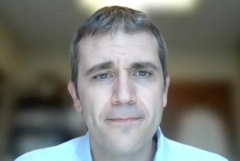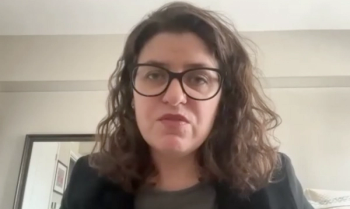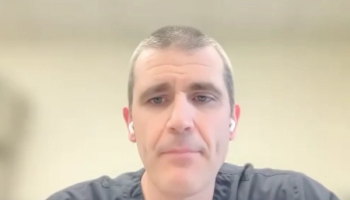
Dr. Nicole Miller discusses AUA 2021 kidney stone highlights

Nicole L. Miller, MD, FACS, discusses studies involving ultrasonic propulsion to facilitate clearance of fragments, dusting vs basketing, and more.
In this video, Nicole L. Miller, MD, FACS, shares noteworthy research in kidney stones from the 2021 American Urological Association Annual Meeting. Miller is a professor of urology at Vanderbilt University Medical Center, in Nashville, Tennessee.
Transcript
Key takeaways from the John K. Lattimer Lecture "Kidney stones: Is prevention possible?" from Glenn M. Preminger, MD
I think the benefit of hearing these important details from Dr. Glenn Preminger is that he really has a career's worth of experience, and that longevity in the field allows you to appreciate new things when they become available. So, he pointed out that there's an increased interest in empiric therapies, particularly with what's called the PUSH trial, which is prevention of urinary stones with hydration. That trial is looking at using smart water bottles to remind patients to drink water because we know that hydration is one of the main things that's a good preventer for kidney stones. So, hopefully we'll be seeing the results of that trial soon.
He also pointed out that there's a new dietary supplement called Moonstone, which was shown to have a higher net citrate content to raise the urinary citrate. We know citrate is an inhibitor for, particularly, calcium oxalate stones, so this was a nice way of finding a supplement to increase urinary citrate rather than necessarily prescribing medications.
He also reported on some research from Duke, his institution, looking at alternate alkali therapies. We use alkali to raise your MPH and to raise citrate, and typically it's potassium citrate that we're using. In this situation, we're finding that patients are complaining that they often can't afford the medication or they're not able to tolerate it. And so, that has led a lot of investigators to look at alternate alkali availabilities. He reported on a study that they did there, looking at both sodium and potassium bicarbonate. They found that both raised not only the urine pH, but also the citrate and were much less expensive. So, that could be another source for both patients and for investigators to get citrate to their patients.
He additionally talked in detail about how we're improving our understanding of the role that oxalate plays in calcium oxalate stone formation, particularly understanding the sources for both intestinal contributions to oxalate as well as hepatic contributions. Being able to potentially manipulate the enzymes that we know are present in the intestinal tract, or degrading oxalate, and finding a way to actually administer that to patients. That's exciting.
And then the last thing that was really a take-home message, I thought, which we haven't spent a lot of time talking about, was the genetic considerations of stone disease. He pointed out that 11% of adults and 29% of patients under the age of 25 have some kind of monogenic genetic mutation that's probably responsible for their kidney stone forming, and that we should all be thinking about that when we see these highly recurrent stone formers and consider genetic testing. He talked about how much research is being done, such as targeted therapy, particularly for primary hyperoxaluria. He mentioned what are called "small interfering RNAs," which are a type of targeted therapy. Essentially, they are natural mechanisms by which you target and suppress the gene sequence for a certain protein. There's a lot of drugs that are coming out, ones looking at primary hyperoxaluria type 1, where they examine these gene therapies and medications that target certain gene sequences. That's really exciting for some of the rare stone disorders. There’s much to still be done in that area, but it is an exciting time for stone disease.
PD26-03: One Year Follow-up of Patients from the Endourologic Disease Group for Excellence (EDGE) Dusting Vs Basketing Trial
Full disclosure, I'm one of the authors of this study and one of the founding members of this Endourology Disease Group for Excellence (EDGE). This research consortium exists specifically to answer very important questions in endourology that we can't answer with a single-institution study. And one of those questions has always been: Which is the best way to treat a stone? Do you dust it or do you basket it? In reality, we all use a combined technique, but usually go in looking at the stone to try to help us decide how best to treat it.
In this study that was presented at the AUA, we were looking at a longer term follow up. The initial report was just looking at stone-free rates at 6 weeks. This is now following those patients out to a mean follow up of over 6 years and seeing if there was any difference because the stone-free rates were actually higher in the fragmenting and basketing group than they were in the dusting group. So, the question becomes: If you have a higher rate of residual fragments, does that translate into actual problems with stones - stone recurrences, stone events, more surgeries? Looking at the patients in the longer term is critical because we want to know what the impact is of those rigid residual fragments. This abstract showed there was really no difference in stone-related events. There's no difference in the surgeries that they needed or the hospitalizations that they needed, even though when we looked at stone recurrence. For example, how often did that patient have what looked like stone activity using imaging? A new stone was actually higher in the dusting group.
The take-home message is that fragmenting/basketing had a better stone-free rate initially, and this method is consistent 6 years out. But if you leave these residual stones, as was true in the dusting group, it doesn't necessarily translate to poor outcomes, such as ER admissions, stone-related surgeries and stone events. So, I think that's somewhat reassuring. I also think the dusting debate is going to continue to be a topic of conversation because, with the new high-powered lasers, the thulium fiber laser and the MOSES laser, the whole idea is to achieve better dusting, even potentially getting dust particles that are so small that you could simultaneously suction them out while you're fragmenting. This could be a true reality in endourology. So, I think the trend overall for bigger stones, ureteroscopically, is going to be dusting. We're all familiar with the smaller, harder stone. That's going to be difficult to dust, and that's much better treated with fragmentation and basketing. I don't think you're wrong picking either technique. It is definitely the stone that that tells you how it should be treated by density, by size, and by composition.
LBA01-06: Randomized control trial of ultrasonic propulsion to facilitate clearance of chronic residual fragments
I've been following, with great interest, the research that's been coming from this group that looks at ultrasonic propulsion of stones. It's such an interesting technology because it's 100% noninvasive, and they have shown in previous reports how they can absolutely move stones with ultrasound, and that it's well tolerated and safe. And so now, in this abstract, they're showing us an example of how they used it clinically in a patient with residual stones, and how, after treating the stone with ultrasonic, the patient had passed 9 of the stone fragments that they saw within 2 hours of the treatment. And so, we just had a debate about dusting versus basketing and the concern about leaving residual fragments. I talked about how you could suction them out while you're lasering. Well, here's another way you could noninvasively move the residual fragments out of the kidneys so that the patient could pass them spontaneously. I think what that will ultimately do is continue to allow us to use the most minimally invasive techniques to treat stones, rather than necessarily treating every stone percutaneously. Now, maybe we can push a little bit more the limits of retrograde intrarenal surgery and ureteroscopy with novel technologies like this.
PD54-02: The Impact of Ureteral Stent Omission and Opiate-Free Protocol on Patient Reported Outcomes Following Ureteroscopy
I think this paper from Dr. Khurshid Ghani and his group in Michigan is really important because we need to pay attention to the patient-reported outcomes. The patient's concerns, expectations and needs don't always fit perfectly with what the surgeons think are important. Stone-free rate is a perfect example. Every surgeon wants their patients to be stone-free, but there are patients that are willing to take a less-invasive surgery, say Shockwave lithotripsy, and accept a lower stone-free rate for something that's less invasive. So, that's just an example of how we really end up having to share decision-making with patients. What we do know is that the ureteral stent that we place, whether it be for ureteroscopy, or whether it be for PCNL, has symptoms related to it that the patients often complained about. There has been a lot of debate over the years of whether a stent is really needed after every ureteroscopic procedure. Certainly, it's been shown by randomized control trials that if it's uncomplicated ureteroscopy then a stent isn't required. And yet, we do it routinely, and the masters of endourology always admit that on every forum. They say, "Well, we know we have good randomized controlled trial data that says we don't have to put a stent in, but we do anyway because we feel like we're safer if we do and then we know why the patients are having pain."
I think what Dr. Ghani was trying to do in this study was look at what was the impact on patient-reported outcomes if you omitted the stent. And so, they used PROMISE scoring. PROMISE scoring is a patient-reported outcome. It looks at 2 different scales: Pain intensity, how intense the pain was on a scale, and then also pain interference, how much that pain interfered with activities of daily living. They all get scores. Essentially, what they were able to show in this in this abstract was that if you omitted the stent, the patient-reported outcomes in both pain intensity and in pain interference were less. So, just as we would potentially expect, if you don't put a stent in, patients do reasonably well as long as you pick the right cases. It'll show in the patient outcomes.
They also looked at how using an opioid-free protocol impacted these PROMISE scores. In our own study that we published looking at opioid-free protocols, we also used PROMISE scoring to look at patient-reported outcomes. In our intervention group, where we took the opioids away, we saw just slightly higher PROMISE scores, but it wasn't clinically significant. And what this abstract shows was that there was actually no difference in PROMISE scores. Patients who you gave opioids to or who you didn't give opioids to had no difference in their pain intensity or their pain interference. So, it gives us the confidence that when we're employing these opioid-free protocols, it's not resulting in poor patient outcomes as the patient sees it. Patient-reported outcomes are not changed, which is really an important aspect because if you're going to succeed in these opioid-free protocols and enhanced recovery after surgery protocols, the patient is a key participant as far as they need the education to understand why we're doing it. They need to buy in to the regimen that you're prescribing, and we need to understand what multimodal analgesia is. We're not expecting them to have zero pain, but we are using different avenues to control the source of the pain. That doesn't necessarily require opioids.
Newsletter
Stay current with the latest urology news and practice-changing insights — sign up now for the essential updates every urologist needs.























